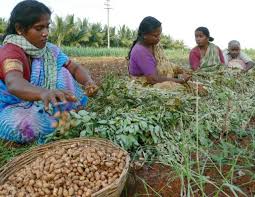Do you know that prolonged drought can cause cancer of the liver?
Aflatoxin, a liver cancer-causing agent produced by fungi, accumulates on crops like maize, sorghum, coffee and groundnut as a result of stress from prolonged droughts.
Exposure to aflatoxin is responsible for 25,200—155,000 liver cancer cases worldwide, according to a UN study. Short-term high exposure, reported from India and Thailand, can be deadly while low-level chronic exposure causes liver damage and cancer, especially where the hepatitis virus is present.
About 4.5 billion people in developing countries are already exposed to uncontrolled and unmonitored amounts of this fungal toxin in their diet, according to a UN Environment Programme (UNEP) Frontiers report, released this year.
Indian groundnut crops are prone to aflatoxin (so are maize, coffee, and sorghum)
Hari Kishan Sudini, senior scientist in groundnut pathology and aflatoxin expert at the Hyderabad-based International Crops Research Institute for the Semi-Arid Tropics (ICRISAT), says aflatoxin is a major issue in India as the second largest world producer of groundnut, a highly prone crop.
An ICRISAT survey of 15,000 farmers in five different Indian states that was completed in 2015, found 90 per cent of groundnut farmers having no idea about aflatoxin. “Because it is not yield-limiting, farmers are not giving it any importance,” Sudini explains.
Peanut oil may be safe because oil extraction process eliminates the poisonous fungus. But more and more people are eating peanuts(groundnuts)thinking it a ‘healthy choice’.
“What is worrying is that direct consumption of groundnuts in India is increasing from the earlier 10—20 per cent, with the bulk going into oil extraction which eliminates the toxin. As countries tighten permissible limits for the toxin, more and more infected export-rejects will find their way into domestic markets,” Sudini has clarified.
India has a high permissible aflatoxin level of 30 micrograms per kilogram as compared to Europe’s four micrograms for direct consumption, 15 micrograms for processed products and 20 micrograms for bird feed. A 2016 climate change simulation predicts that aflatoxin will become a food safety issue for Europe in the likely scenario of a two-degree rise in global temperatures.
“Depending on the level of contamination, maize and peanuts can be chemically treated or mixed with a binding agent like calcium montmorillonite clay and fed to animals,” Harvey said. Contaminated crops can also be used for bio-fuels.
“However, many farmers sort out mouldy-looking kernels to feed livestock, though this is detrimental to livestock health — clean-looking grains can still have high levels of toxin,” Harvey added. “The challenge is that contaminated harvest can coincide with drought when alternative food is unavailable.”
“Although researchers have been aware of aflatoxin food contamination, they now recognise the magnitude of toxin-related issues facing farmers as droughts become more frequent and severe with warmer zones moving to higher altitudes,” says Jagger Harvey, who leads USAID’s ‘Feed the Future Innovation Lab for the Reduction of Post-Harvest Loss’ at Kansas State University.
“There is potential risk of childhood stunting which affects mental and physical development well beyond childhood in low- to mid-income regions like South Asia,” Harvey claimed at the UN Environment Assembly held May in Nairobi.
Aflatoxin contamination of food and feed raises questions of risks to public health as well as barriers to trade. The fact that the 2011— 2015 was the hottest period on record for several decades is bad news for farmers on South Asia’s largely rain-fed farmlands.
Deforestation causes Climate change and global warming which causes drought, and now we learn that heat and drought increases a poisonous fungus on crops that caused liver cancer!


